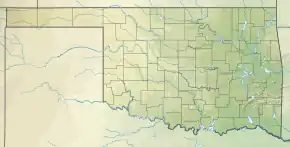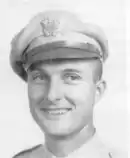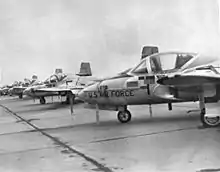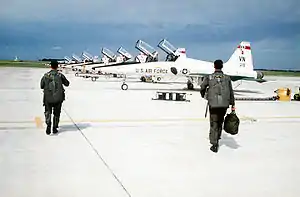| Vance Air Force Base | |||||||||||
|---|---|---|---|---|---|---|---|---|---|---|---|
| Near Enid, Oklahoma in the United States of America | |||||||||||
 T-38C Talons at Vance Air Force Base. | |||||||||||
 | |||||||||||
 Vance AFB  Vance AFB  Vance AFB | |||||||||||
| Coordinates | 36°20′21″N 97°54′59″W / 36.33917°N 97.91639°W | ||||||||||
| Type | U.S. Air Force Base | ||||||||||
| Site information | |||||||||||
| Owner | Department of Defense | ||||||||||
| Operator | U.S. Air Force | ||||||||||
| Controlled by | Air Education and Training Command (AETC) | ||||||||||
| Condition | Operational | ||||||||||
| Website | www.vance.af.mi | ||||||||||
| Site history | |||||||||||
| Built | 1941 | ||||||||||
| In use | 1941 – present | ||||||||||
| Garrison information | |||||||||||
| Current commander | Colonel Charles D. Throckmorton IV | ||||||||||
| Garrison | 71st Flying Training Wing (Host) | ||||||||||
| Airfield information | |||||||||||
| Identifiers | IATA: END, ICAO: KEND, FAA LID: END, WMO: 723535 | ||||||||||
| Elevation | 398.3 metres (1,307 ft) AMSL | ||||||||||
| |||||||||||
| Source: Federal Aviation Administration[1] | |||||||||||
Vance Air Force Base (IATA: END, ICAO: KEND, FAA LID: END) is a United States Air Force base located in southern Enid, Oklahoma, about 65 mi (105 km) north northwest of Oklahoma City. The base is named after local World War II hero and Medal of Honor recipient, Lieutenant Colonel Leon Robert Vance Jr.
The host unit at Vance is the 71st Flying Training Wing (71 FTW), which is a part of Air Education and Training Command (AETC). The commander of the 71 FTW is Colonel Charles D. Throckmorton IV. The vice-commander is Colonel Charles Schuck and the command chief is Chief Master Sergeant Brandon Smith.
History
World War II

Construction began on 12 July 1941 for a cost of $4,034,583. United States Army Air Corps project officer, Major Henry W. Dorr supervised the construction and developed the basic pilot training base. In 1941, for the sum of $1 a year, this land was leased from the city of Enid to the federal government as a site for a pilot training field, and on November 21 the base was officially activated. The installation was without a name, but was generally referred to as Air Corps Basic Flying School. The mission of the school was to train aviation cadets to become aircraft pilots and commissioned officers in the United States Army Air Forces (USAAF).
The facility was assigned to the USAAF Gulf Coast Training Center, with the Army Air Force Pilot School (Primary) activated (phase 1 pilot training), in which flight cadets were taught basic flight using two-seater training aircraft. Fairchild PT-19s were the primary trainer used.
It was not until 1942 that the base was officially named Enid Army Flying School, also known as Woodring Field. It was officially activated on 11 February 1942. On 8 January 1943, the War Department constituted and activated the 31st Flying Training Wing (Primary) at Enid and assigned it to the USAAF Central Flying Training Command. For the duration of the war, the basic phase of training graduated 8,169 students, while the advanced phase of training graduated 826.
As the demand for pilots decreased with the end of the war in Europe, the Enid Army Flying Field began ramping down pilot production and deactivated on 31 January 1947, by which time 9,895 USAAF pilots had earned wings there.[2] In 1946, Alva, Oklahoma native Floyd E. Welsh, the War Surplus Property Officer in Washington, D.C., had pigeonholed the Enid AAF folder when it crossed his desk for disposal action. Two years later the Soviet Union blockaded Berlin, Germany, and U.S. president Harry S. Truman ordered an airlift to resupply the city. The United States Air Force (USAF), realizing a need for training facilities, asked Welsh if any World War II airfields remained in inventory. He exhumed the Enid AAF folder, and the base was reactivated on August 1, 1948, as Enid Air Force Base.
Cold War
Reactivated as Enid Air Force Base, the installation became one of several pilot training bases within the Air Training Command (ATC). Its initial mission was to provide training for advanced students in multi-engine aircraft. On July 9, 1949, in keeping with the USAF tradition of naming bases for deceased flyers, the base was renamed for Lieutenant Colonel Leon Robert Vance Jr., USAAF, an Enid native who was awarded the Medal of Honor in World War II.

The first aircraft flown at Vance when it was still Enid AAF was the BT-13A, followed shortly by the BT-15. In 1944, advanced students flew the TB-25 and TB-26. Following the establishment of the United States Air Force as a separate service in September 1947, Enid AFB-turned-Vance AFB began conducting training in the AT-6 Texan and eventually the T-33 Shooting Star. The T-37 Tweet first flew at Vance AFB beginning in 1961, and the T-38 Talon in 1963 as the USAF transitioned to its Undergraduate Pilot Training (UPT) system.
Post Cold War
In 1995 USAF officials announced that Vance would transition to the Specialized Undergraduate Pilot Training curriculum. Under SUPT, Vance students begin their training in the Beechcraft T-6 Texan II, followed by the T-1A Jayhawk for students identified for jet tanker, transport or large reconnaissance aircraft, and the T-38 Talon for fighter, bomber and other USAF fixed-wing aircraft.

With the introduction of the Joint Primary Aircraft Training System (JPATS) to Vance in 2005, the 71 FTW began transitioning from the T-37 to the newer T-6 Texan II. Joint training with the United States Navy (USN) and United States Marine Corps (USMC) began at Vance in 1996, with select USN and USMC strike jet student naval aviators obtaining all training at Vance in the T-37 and T-38 except for carrier qualification, which they subsequently complete in the T-45 Goshawk at Naval Air Station Meridian, Mississippi or NAS Kingsville, Texas. A number of senior naval aviators in the rank of commander have also served as squadron commander in the 71 FTW. Today, student naval aviators only undergo primary T-6 training at Vance, transitioning to USN/USMC strike jet pipeline, the USN/USMC/United States Coast Guard (USCG) multi-engine maritime pipeline, or the USN/USMC/USCG rotary-wing and tilt-rotor pipeline at respective naval air stations in Florida, Texas or Mississippi.
All students practice basic patterns and landings at Kegelman Air Force Auxiliary Field located near Cherokee, Oklahoma. Vance is considered the second busiest RAPCON facility in the United States, behind Nellis AFB. Nellis AFB is open 24 hours, but Vance AFB has more traffic per hour.
Major Commands
- Gulf Coast Training Center (Air Corps), December 18, 1941 – January 23, 1942
- Air Corps Flying Training Comd, January 23, 1942 – March 15, 1942
- AAF Flying Training Comd, March 15, 1942 – July 31, 1943
- Army Air Forces Training Command, July 31, 1943 – July 1, 1946
- Air Training Command, July 1, 1946 – July 1, 1993
- Air Education and Training Command, July 2, 1993 – present
Base operating units
- 80th Air Base Sq, November 29, 1941 – June 13, 1942
- 80th Base HQ and Air Base Sq, June 13, 1942 – May 1, 1944
- 2518th AAF Base Unit (Pilot School, Basic), May 1, 1944 – February 4, 1945
- 2518th AAF Base Unit [Pilot School, Advanced-2E], February 4, 1945 – September 26, 1947
- 2518th AF Base Unit, September 26, 1947 – August 26, 1948
- 3575th Air Base Gp, August 26, 1948 – November 1, 1972
- 71st Air Base Gp, November 1, 1972 – present

Major units assigned
- 60th Air Base Group November 29, 1941 – December 20, 1942
- 31st Flight Training Wing January 16, 1943 – May 15, 1945
- 2518th Army Air Force/Air Force Base Unit May 1, 1944 – August 28, 1948
- 3575 Pilot Training Wing August 26, 1948 – November 1, 1972
- 8600 Pilot Training Wing June 27, 1949 – May 28, 1951
- 71st Flying Training Wing November 1, 1972 – present
- Enid Composite Squadron Civil Air Patrol
Mission
The 71st Flying Training Wing aims to train world-class pilots for the United States Air Force, Navy, Marine Corps, and its allies and to prepare Air Expeditionary Force (AEF) warriors to deploy in support of the combatant commanders.
Based units
Flying and notable non-flying units based at Vance Air Force Base.[3][4]
Units marked GSU are Geographically Separate Units, which although based at Vance, are subordinate to a parent unit based at another location.
United States Air Force
|
Air Education and Training Command (AETC)
|
Air Force Reserve Command (AFRC)
|
See also
References
- ↑ "Airport Diagram – Vance AFB (KEND)" (PDF). Federal Aviation Administration. 10 October 2019. Retrieved 30 October 2019.
- ↑ "Vance Air Force Base | the Encyclopedia of Oklahoma History and Culture".
- ↑ "Vance AFB". MyBaseGuide. 15 October 2018. Retrieved 30 October 2019.
- ↑ "Flying Training Squadrons". 340th Flying Training Group. US Air Force. Retrieved 30 October 2019.
Other sources
 This article incorporates public domain material from the Air Force Historical Research Agency
This article incorporates public domain material from the Air Force Historical Research Agency- Manning, Thomas A. (2005), History of Air Education and Training Command, 1942–2002. Office of History and Research, Headquarters, AETC, Randolph AFB, Texas OCLC 71006954, 29991467
- Mueller, Robert (1989). Active Air Force Bases Within the United States of America on September 17, 1982. USAF Reference Series, Maxwell AFB, Alabama: Office of Air Force History. ISBN 0-912799-53-6
- Ravenstein, Charles A. (1984). Air Force Combat Wings Lineage and Honors Histories 1947–1977. Maxwell AFB, Alabama: Office of Air Force History. ISBN 0-912799-12-9.
- Shaw, Frederick J. (2004), Locating Air Force Base Sites, History’s Legacy, Air Force History and Museums Program, United States Air Force, Washington DC. OCLC 57007862, 1050653629
- Much of this text in an early version of this article was taken from pages on the Vance Air Force Base Website, which as a work of the U.S. Government is presumed to be a public domain resource.
External links
- Vance Air Force Base, official web site
- Vance AFB at GlobalSecurity.org
- Vance AFB Installation Overview from AirForceUSA.org.
- FAA Airport Diagram (PDF), effective December 28, 2023
- FAA Terminal Procedures for END, effective December 28, 2023
- Resources for this U.S. military airport:
- FAA airport information for END
- AirNav airport information for KEND
- ASN accident history for END
- NOAA/NWS latest weather observations
- SkyVector aeronautical chart for KEND


